RELG 433 - Biblical Archaeology
Module 9 Course Notes - The Philistines
Iron Age I, ca. 1,200 - 1,000 BC
Images in the text are linked to larger photos - click on them to see the larger pictures.
Hover the mouse over the images to see their captions and copyright credits.
 Subdivisions of the Iron Age
Subdivisions of the Iron Age
In Canaan/Israel/Palestine the Iron Age is best subdivided into periods which correspond to the Hebrew political and economic development.
- Iron Age IA : 1,200 - 1,150 BC, corresponding to the 20th Dynasty of Egypt.
- Iron Age IB : 1,150 - 1,000 BC - corresponding to the 21st Dynasty of Egypt.
- Iron Age IIA : 1,000 - 925 BC, corresponding to the reigns of King David and King Solomon - David made Jerusalem the capital of Israel, Solomon built the first Temple, and the kingdom became relatively wealthy and powerful.
- Iron Age IIB : 925 - 720 BC, corresponding to the break-up of the kingdom, after Solomon's death, into two separate kingdoms - "Israel" in the central and northern part of the land, and "Judah" in the south. The capital of Judah was always Jerusalem, but the capital of the northern kingdom changed several times according to the wishes of whoever happened to be king. This period ended when the northern kingdom of Israel was over-run by the Assyrians, the Israelites were deported to other parts of the Assyrian Empire, and an ethnically mixed group of people were moved into the land by the Assyrians.
- Iron Age IIC : 720 - 586 BC, corresponding to the period when the southern kingdom of Judah was virtually a buffer-state between the Egyptians and the Assyrian Empire, and later, the Babylonians. This came to an end when the Babylonians, who had conquered the Assyrians, invaded Judah, burned Jerusalem and the First Temple, and deported most of the Jews.
 The Origins of Iron Technology
The Origins of Iron Technology
The Hittites, and then the Sea Peoples, were probably the ones who developed iron technology in the Near East.
Turkey, the homeland of the Hittites, was the main source of iron ore in ancient times, so it is logical that the people living there would be the ones to explore the uses of the ore, and to start manufacturing iron tools from its ores (rather than from meteoritic iron). Given the probable origins of the Sea Peoples in the region of the Aegean, and their known use of iron tools and weapons, it is most likely that they had learned this from the Hittite culture in Anatolia. Iron technology had reached Palestine/Israel by the time of the Judges - one of the Israelites' laments was that the inhabitants of Canaan had chariots made of iron (Joshua 17:16,18, Judges 1:19 & 4:3,13)
![]()
 Iron Age I in Canaan
Iron Age I in Canaan
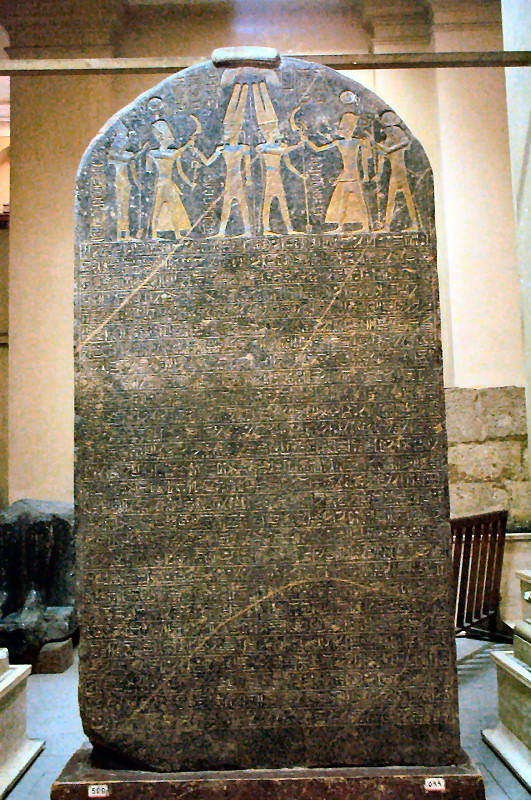
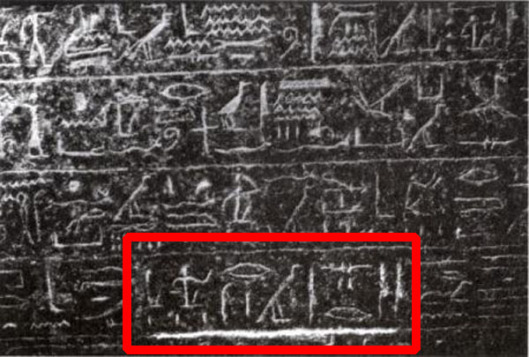 Pharaoh Merneptah, or Merenptah, 1,213 - 1,203 BC, led a military campaign in Canaan, and erected a victory stele - the "Israel Stele" or Merneptah Stele - the first surviving record of the name "Israel", as a tribe, rather than a city.
Pharaoh Merneptah, or Merenptah, 1,213 - 1,203 BC, led a military campaign in Canaan, and erected a victory stele - the "Israel Stele" or Merneptah Stele - the first surviving record of the name "Israel", as a tribe, rather than a city.
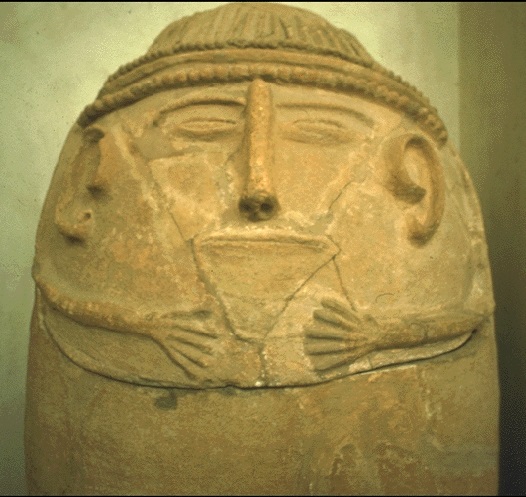 Merneptah also fought off the first invasions of the "Sea Peoples" in Egypt. He was followed by several short-lived weaker pharaohs, and Egyptian influence in Canaan began to wane. There were still some Egyptian military outposts and government centers in larger towns - a cemetery with anthropoid coffins was found at Beth-Shean, along with a statue and an inscription of Ramesses III.
At the beginning of this period, Egyptian influence was still strong, but it declined throughout the period as new ethnic groups settled in the land.
Merneptah also fought off the first invasions of the "Sea Peoples" in Egypt. He was followed by several short-lived weaker pharaohs, and Egyptian influence in Canaan began to wane. There were still some Egyptian military outposts and government centers in larger towns - a cemetery with anthropoid coffins was found at Beth-Shean, along with a statue and an inscription of Ramesses III.
At the beginning of this period, Egyptian influence was still strong, but it declined throughout the period as new ethnic groups settled in the land.
The Canaanites also continued throughout this period.
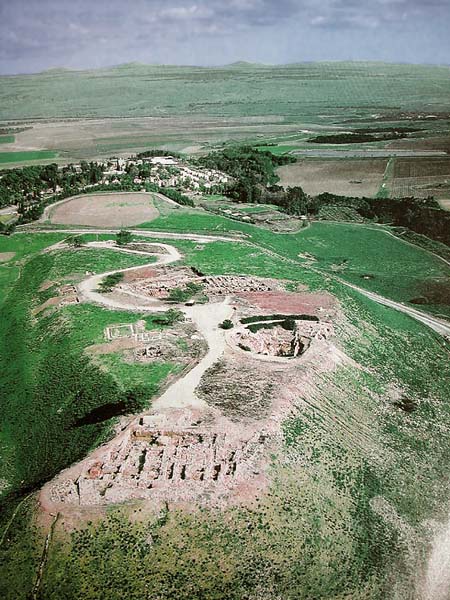
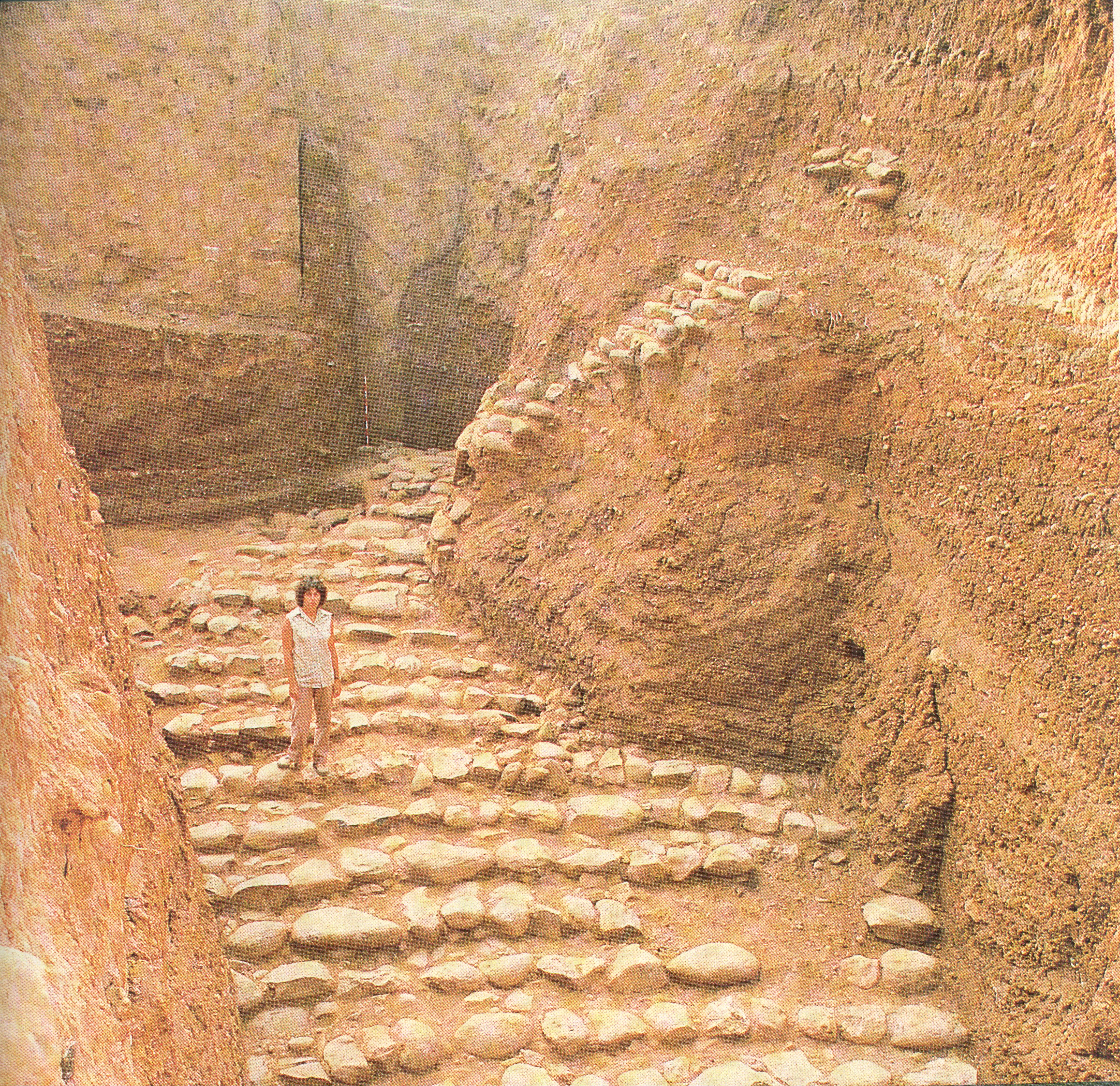
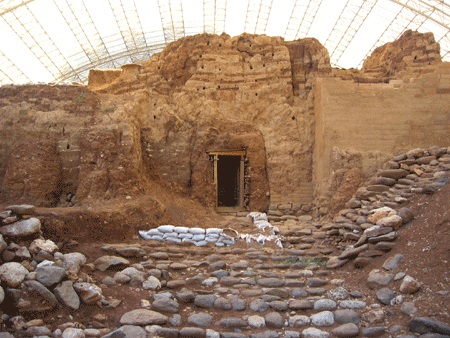 They appear to have been able to hold on to some of their strongholds -
at Megiddo, Beth-Shean, and Hazor. Although there was destruction at the end of the Late Bronze Age, the cities were rebuilt, and show evidence of continuing Canaanite presence.
They appear to have been able to hold on to some of their strongholds -
at Megiddo, Beth-Shean, and Hazor. Although there was destruction at the end of the Late Bronze Age, the cities were rebuilt, and show evidence of continuing Canaanite presence.
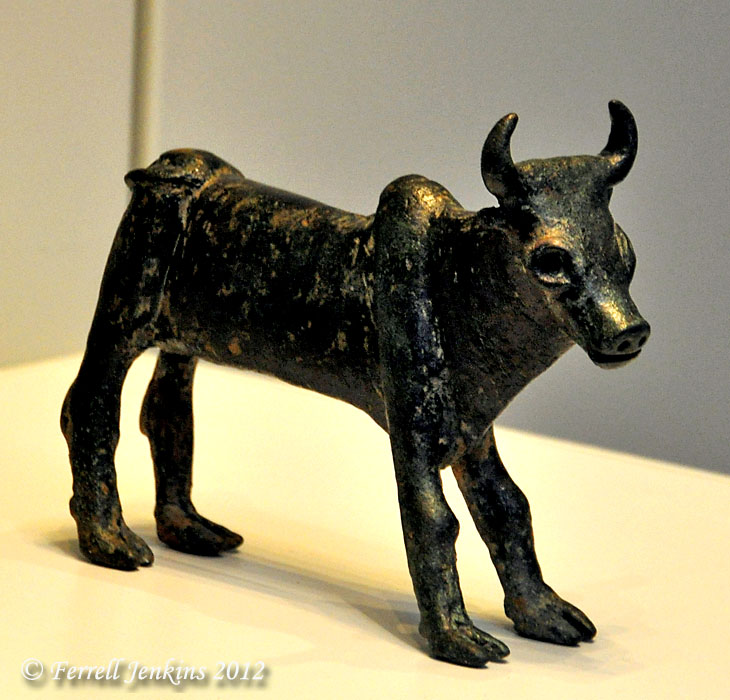

 The bronze statuette of a bull, found in the hills of Samaria, was found in what seems to be a cultic center for the region, rather than a town or settlement. Although it is an article typical of Canaanite religion there is insufficient evidence at the site to show whether or not it is of Canaanite origin.
The bronze statuette of a bull, found in the hills of Samaria, was found in what seems to be a cultic center for the region, rather than a town or settlement. Although it is an article typical of Canaanite religion there is insufficient evidence at the site to show whether or not it is of Canaanite origin.


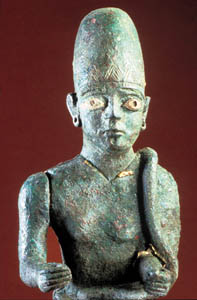
![]()
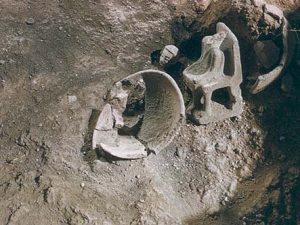
Early excavation at Hazor, by Yigael Yadin in the 1950s-1960s, led him to postulate that the Canaanites at Hazor were displaced by the Israelites. Amnon Ben-Tor has led excavations at Hazor since 1990. In 2017 he published his conclusions that Hazor was destroyed by the Israelites, in a huge fire at the end of Iron Age I. The destruction layer of ashes and charred wood was up to three feet deep. The fire probably started during an attack, and was made worse by the large storage jars of oil which caught fire - the fire destroyed the Canaanite palace and most of the city. During the destruction, Canaanite statues were deliberately destroyed - their heads and feet cut off, and the statues smashed to pieces.
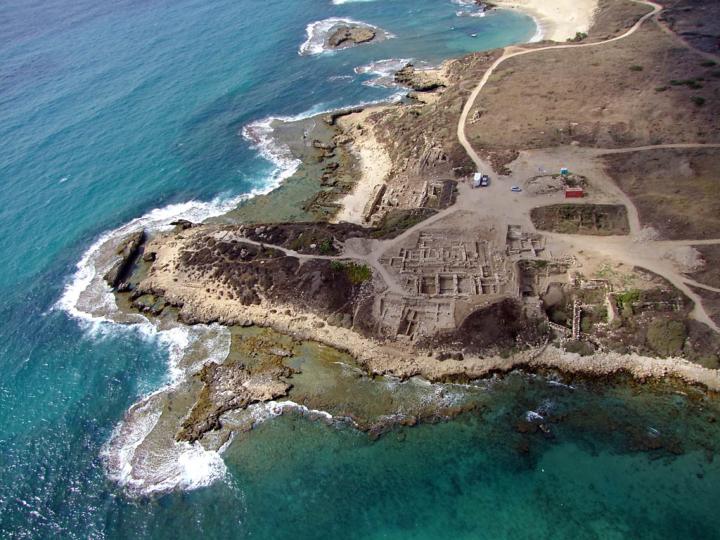

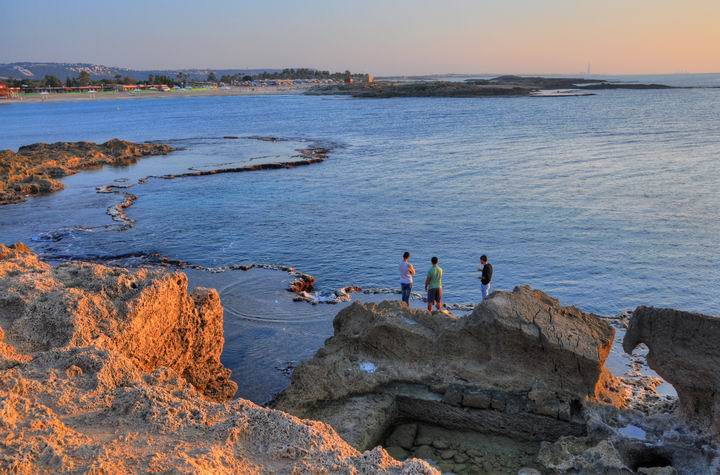 Dor was a harbor on the Mediterranean coast, with occupation from the Canaanite to the Byzantine and later ages. The tel is being continually eroded by the sea. At Dor, it appears that the site was destroyed twice during Iron Age I. There was a large-scale destruction and burnt layer, up to three feet thick, dated by the excavators to ca. 1050 BC, which was followed by a change in material culture. This first destruction appeared to be of a Canaanite town;
Dor was a harbor on the Mediterranean coast, with occupation from the Canaanite to the Byzantine and later ages. The tel is being continually eroded by the sea. At Dor, it appears that the site was destroyed twice during Iron Age I. There was a large-scale destruction and burnt layer, up to three feet thick, dated by the excavators to ca. 1050 BC, which was followed by a change in material culture. This first destruction appeared to be of a Canaanite town;
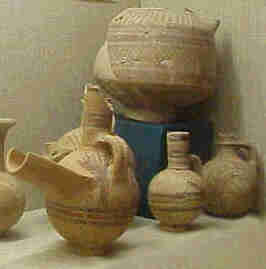 it was followed by a settlement which showed Phoenician or Sea Peoples influence. About 50 years later there was another destruction at Dor, which seems to have been caused by an earthquake. The archaeologists found the skeleton of a woman who had been crushed under the falling walls of her house.
it was followed by a settlement which showed Phoenician or Sea Peoples influence. About 50 years later there was another destruction at Dor, which seems to have been caused by an earthquake. The archaeologists found the skeleton of a woman who had been crushed under the falling walls of her house.
Dor was one of the sites which showed the emergence of a culture containing Canaanite and Sea People influences, which became the Phoenicians.
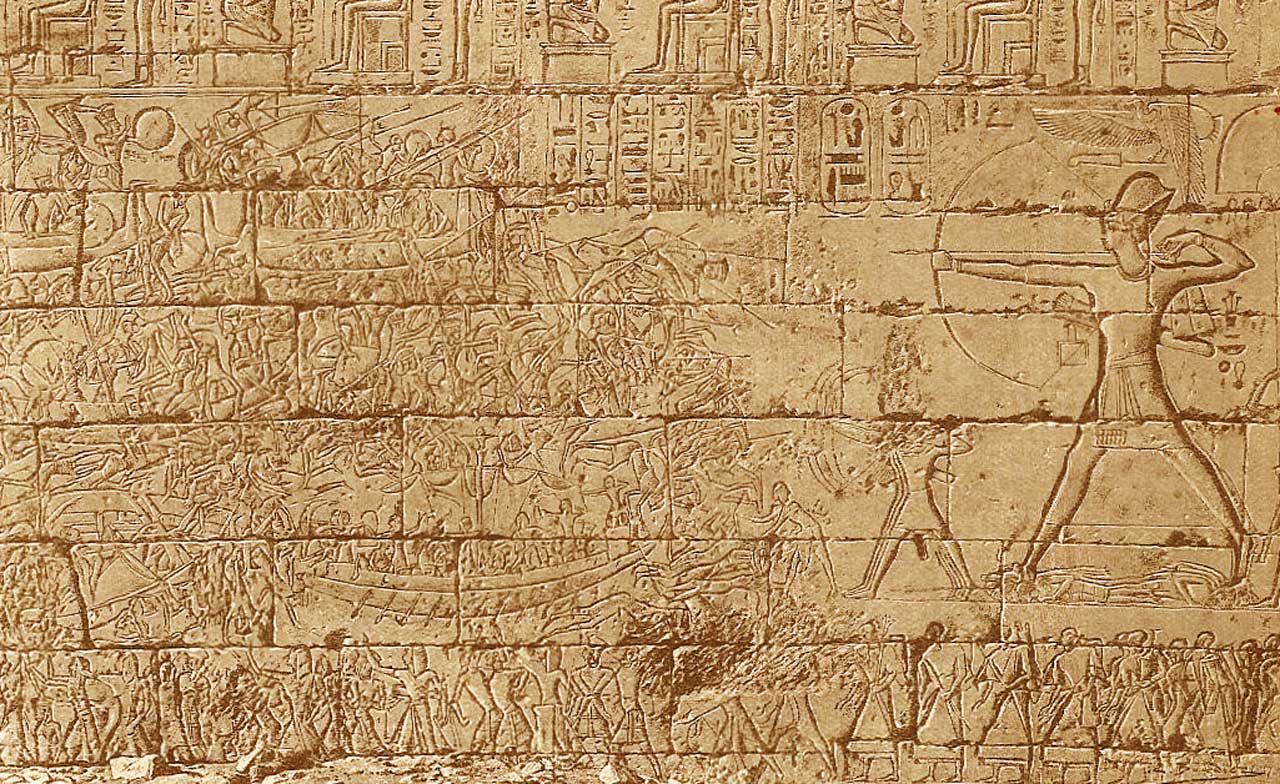

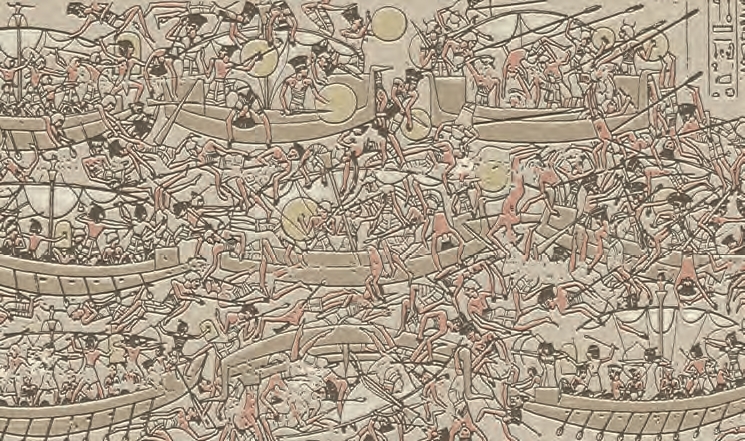 A distinctive new cultural group settled on the coastal strip,
A distinctive new cultural group settled on the coastal strip,
 with all the evidence pointing to it being part of the "Sea Peoples" who had attacked Egypt and been driven off by Ramesses III. The Sea Peoples most probably came from the Aegean and Anatolian regions, and had probably been displaced from there by the "Dorian Invasion" of Greece and the Aegean. The Sea Peoples who settled along what is now the Gaza Strip became the Philistines. The Philistines had a great advantage over their neighbors, in that they knew how to work iron - they brought this knowledge with them to Canaan.
with all the evidence pointing to it being part of the "Sea Peoples" who had attacked Egypt and been driven off by Ramesses III. The Sea Peoples most probably came from the Aegean and Anatolian regions, and had probably been displaced from there by the "Dorian Invasion" of Greece and the Aegean. The Sea Peoples who settled along what is now the Gaza Strip became the Philistines. The Philistines had a great advantage over their neighbors, in that they knew how to work iron - they brought this knowledge with them to Canaan.
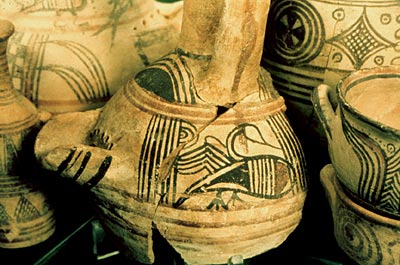
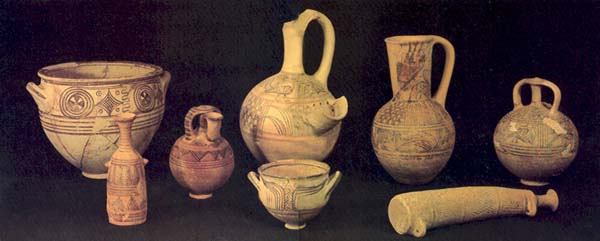
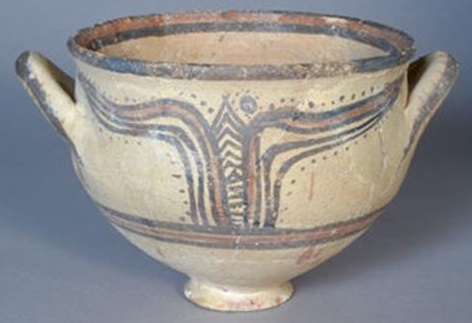
 Philistine pottery had similar shapes and decorations to Mycenaean, supporting the Mycenaean origins of the Philistines
Philistine pottery had similar shapes and decorations to Mycenaean, supporting the Mycenaean origins of the Philistines
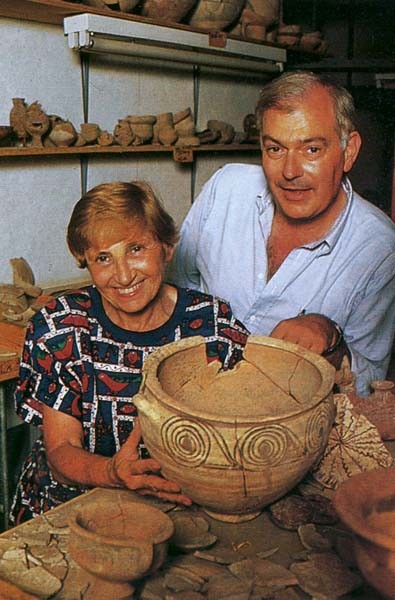 Excavation at Tel Miqne-Ekron, led by Trude Dothan, shows how the Philistines settled in and developed their culture during the Iron Age. The early Iron Age settlement was protected by a mud-brick wall more than 10 feet thick. The city contained an industrial area with number of pottery-kilns, and much locally-made pottery (fine table ware and cooking-pots) in the Mycenaean style.
Excavation at Tel Miqne-Ekron, led by Trude Dothan, shows how the Philistines settled in and developed their culture during the Iron Age. The early Iron Age settlement was protected by a mud-brick wall more than 10 feet thick. The city contained an industrial area with number of pottery-kilns, and much locally-made pottery (fine table ware and cooking-pots) in the Mycenaean style.
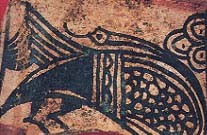 This served to date the arrival of a group of the Sea-Peoples in Iron Age I. There were also several cultic objects, one of them similar to the Ashdoda figure discovered at Ashdod. Layers dated to later in Iron Age I showed evidence of a shrine with a stone pillar-base and several ashdoda-type figures along with other cultic objects.
This served to date the arrival of a group of the Sea-Peoples in Iron Age I. There were also several cultic objects, one of them similar to the Ashdoda figure discovered at Ashdod. Layers dated to later in Iron Age I showed evidence of a shrine with a stone pillar-base and several ashdoda-type figures along with other cultic objects.
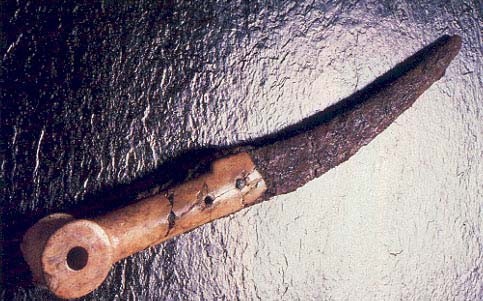 In another part of the city a later large public building was found, with bamoth ('high places' for sacrifices) and many cultic objects, also an iron knife and an ingot of iron, indicating the presence of iron-working. There were several hearths for fires, set in the floor - such hearths were unknown in the Canaanite building tradition, but were a prominent feature of palaces in Mycenaean Greece. Ekron was destroyed in Iron Age II - probably by David, though possibly by the Egyptians. It remained unoccupied for about 270 years.
In another part of the city a later large public building was found, with bamoth ('high places' for sacrifices) and many cultic objects, also an iron knife and an ingot of iron, indicating the presence of iron-working. There were several hearths for fires, set in the floor - such hearths were unknown in the Canaanite building tradition, but were a prominent feature of palaces in Mycenaean Greece. Ekron was destroyed in Iron Age II - probably by David, though possibly by the Egyptians. It remained unoccupied for about 270 years.
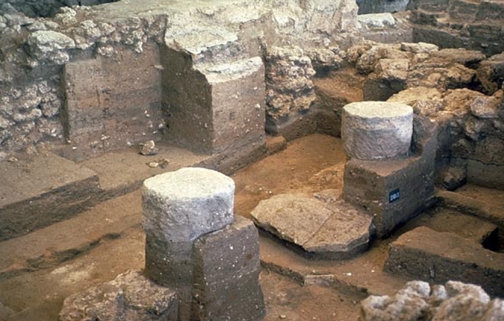
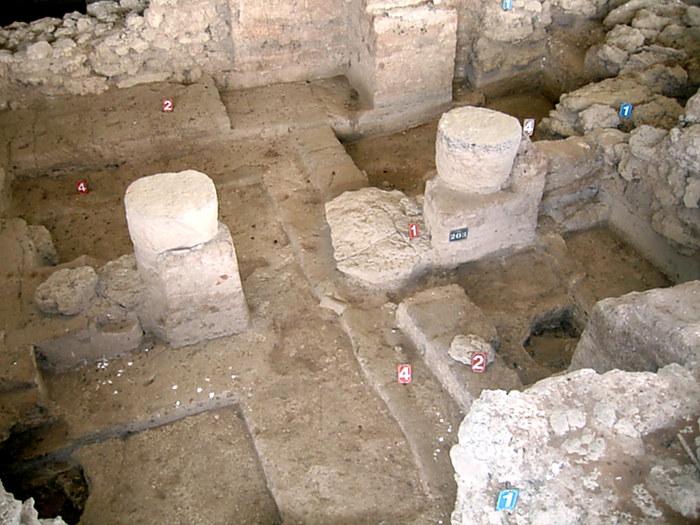
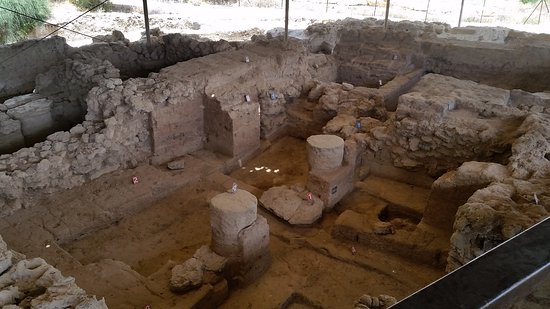

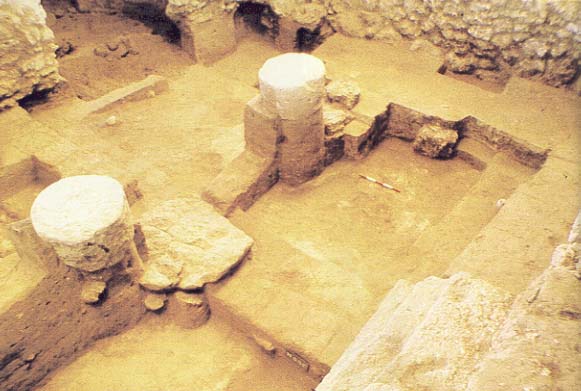

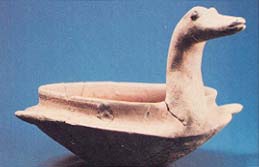
 Tel Qasile (now part of modern Tel Aviv) was first excavated by Benjamin Mazar in 1948. The early settlement was a port town, with square stone houses each comprising two long rectangular rooms and a courtyard. Finds included distinctive locally-produced Philistine pottery, and a Philistine 'temple' which had been rebuilt several times. It featured a pair of stone column bases which had evidently been the foundation supports for a pair of pillars, probably of cedar wood (charred wood was found beside them). The pillars would have been about 6 feet apart from one another - near enough for a large man to stand between them and push against them. Some authors have remarked that this would be similar to the situation described in Judges 17:25-30, in which Samson destroyed the Philistine temple at Gaza.
Tel Qasile (now part of modern Tel Aviv) was first excavated by Benjamin Mazar in 1948. The early settlement was a port town, with square stone houses each comprising two long rectangular rooms and a courtyard. Finds included distinctive locally-produced Philistine pottery, and a Philistine 'temple' which had been rebuilt several times. It featured a pair of stone column bases which had evidently been the foundation supports for a pair of pillars, probably of cedar wood (charred wood was found beside them). The pillars would have been about 6 feet apart from one another - near enough for a large man to stand between them and push against them. Some authors have remarked that this would be similar to the situation described in Judges 17:25-30, in which Samson destroyed the Philistine temple at Gaza.
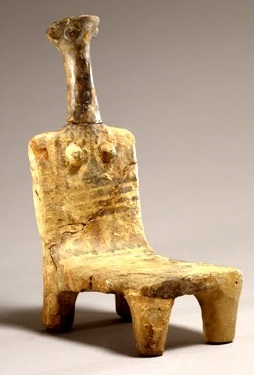
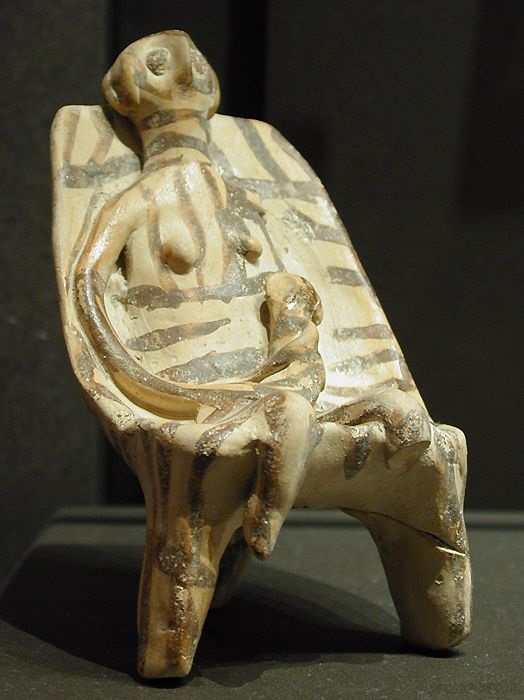
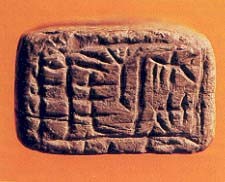 At the Philistine settlement of Ashdod cultic objects have been discovered which show a cultural relationship to the Mycenaeans.
Also, a Philistine stamp-seal was found, with symbols similar to those of the Cypriot script - this is taken as evidence for Philistine literacy.
At the Philistine settlement of Ashdod cultic objects have been discovered which show a cultural relationship to the Mycenaeans.
Also, a Philistine stamp-seal was found, with symbols similar to those of the Cypriot script - this is taken as evidence for Philistine literacy.
Another distinct cultural group of migrants who settled in Canaan developed into what is recognized as the Israelite culture. Some archaeologists argue against the literal account of the Exodus and the entry into Canaan of 12 tribes under the leadership of Joshua, while others see the archaeological results as supporting the Biblical account. What is certain is that by the end of Iron I there was a new cultural group in the land, which can be identified with the Israelites.
Copyright © 1999 Shirley J. Rollinson, all Rights Reserved